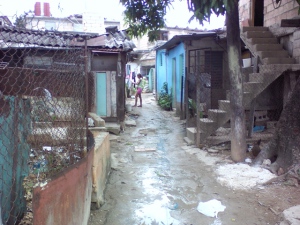A series of events in the Romerillo neighbourhood has caused unrest among the local inhabitants and should draw the attention of both the government and the authorities of the Playa municipality.
Embedded in an area close to the 5th Avenue and within the reach of several iconic sites such as the Palacio de las Convenciones and the children’s playground of La Isla del Coco, Romerillo used to be a famous neighbourhood before the triumph of the Revolution thanks to its clubs, bars and inns, highly visited both by local people and foreign tourists.

Peeking into the history, we find out that the local trade disappeared in 1959. The neighbourhood then saw a remarkable growth, as many Cubans from different provinces came to the capital in search of better living conditions. The exodus was boosted by the start of the Special Period in the peaceful times, when the settlements known as El Palo and La Aldea were founded, typical for their crowded, desolate shacks.
“This neighbourhood is violent by its nature,” says Tonito, resident of the El Gordo passage. “In the last days, there has been an increase in blood crimes and it’s rather scary to see how easily people blow up now. Last night, a friend of mine was killed with a machete at the station in the 9th Street and a few days ago, another young man was stabbed in front of a Yoruba priest in Pititi.”
Katia and Marlene, two residents of the neighbourhood, spent 4 days detained at the police station known as ‘la quinta’ for disturbing public order. Katia, who was born in Guantánamo, has lived in La Aldea for twenty years and says the situation is difficult.
“Sometimes it’s not the residents of Romerillo who stir up trouble. The neighbourhood is attractive, it has a lot to offer, if you know what I mean… People from other places come to enjoy themselves and when they get crazy, it’s when the problems start. That day I was taking a quiet walk with my daughter Marlene and some guys from the Pogolotti neighbourhood started to behave disrespectfully towards us. To us, who won’t tolerate such things! So, there we were, starting a fight. Knives, machetes, stones, two women against three men, fighting our way from the El Gordo passage to the very door of our house, beating them like drums.
“My brother Giro was asleep but he woke up at hearing all the shouting. He went out and tried to calm the situation down,” adds Marlene. “It was him who got injured with a machete. He was hit on the head and arm and lost a finger. Now he has to undergo a surgery. Who said that people should try to settle arguments in a peaceful way? In a fight you have to lash out left and right!”
Luis Padilla is a sociologist living very close to this neighbourhood at the northwest suburb of Havana. He tries to explain the causes of the notorious inclination of the Romerillo inhabitants to solve their disputes by brute force.
“Poverty generates violence,” says Padilla. “The people here have little money, they don’t have enough to meet their basic needs. They lead bad lives, live on poor diets, sleep little, drink every day to ‘forget the pain’, killing themselves on their own. As Cubans we are of a loud disposition, we tend to exaggerate and go beyond measure and use aggressive language. In the suburban slums, these characteristics get quadrupled. People living in those areas have developed a mechanism of self-defence: they like to swagger and constantly manifest their superiority over the peers.”
Cacha, a retired construction worker, comments:
“Almost all men in the Pititi passage have once been imprisoned – for drugs, homicide or armed robbery. There even lives a woman who beat up her husband for having hit and abused her sister. I cannot say for sure that it’s the worst neighbourhood in Havana, but every weekend there’s a fight and a blood crime.”
Nereida, an elderly woman living in a house with overflowing sewage drain who no longer leaves her house, reasons:
“Daggers and machetes are not the only weapons killing La Aldea residents. Alcohol and bad luck are also culprits that often take the lives of local people. A mathematician died yesterday who lived in the other passage; he was an eminent scientist, but the alcohol finished him off. He didn’t live up to his fortieth birthday, but looked as if he were eighty. And the day before, another frustrated professor had died, whom they called “rebola”. He worked as a gardener in 5th Avenue and was pruning flowers in flowerbeds when a drunken American Cuban who had lost control over his car left the road and ended up in the median strip, driving him over. His coffin at the vigil had to be closed because – hard as they tried, they weren’t able to reassemble his head. Two tragedies I have recently heard of, but there are others that you will never learn about…”

Leave a comment